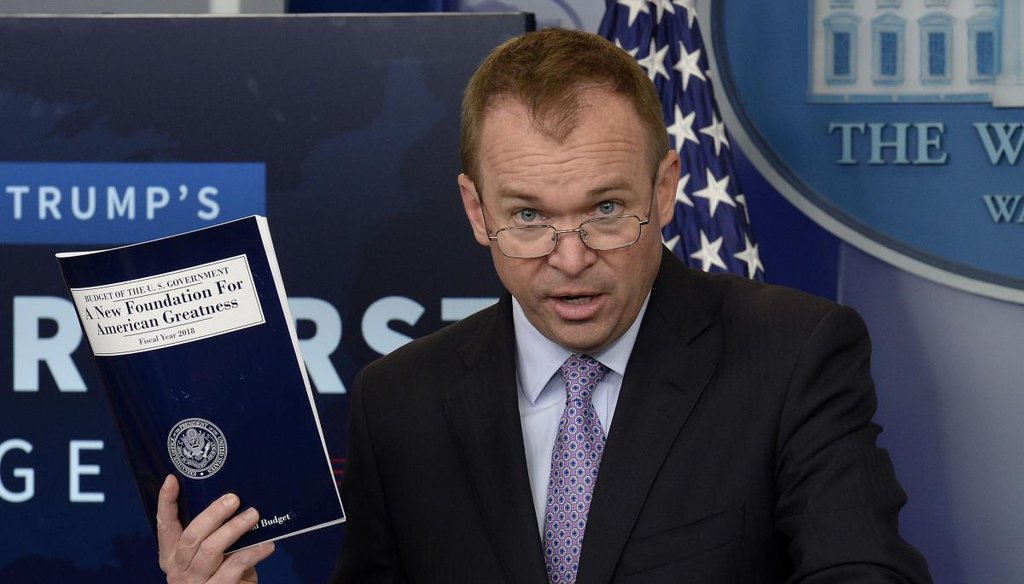Stand up for the facts!
Our only agenda is to publish the truth so you can be an informed participant in democracy.
We need your help.
I would like to contribute
Trump budget proposal claims balanced budget, CBO disagrees

Office of Management and Budget Director Mick Mulvaney speaks during a press briefing about President Donald Trump's 2018 budget proposal at the White House on May 23, 2017, in Washington (TNS)
Prior to taking office, President Donald Trump promised to balance the federal budget by making small reductions in spending each year.
"If we save just one penny of each federal dollar spent on non-defense, and non-entitlement programs, we can save almost $1 trillion over the next decade," Trump said in a September 2016 campaign speech at the New York Economic Club in Manhattan. "If our plan exceeds the 3.5 percent 10-year growth average, then our jobs proposal will actually reduce the deficit."
Exactly when could Americans expect to see a balanced budget?
Trump didn't give a timeframe to Fox News anchor Sean Hannity when Hannity asked earlier that year. Instead, he said it would be done "fairly quickly," but it would take longer than one or two years.
The White House took its first steps to balance the budget with its release of the president's FY 2018 spending proposal, in which Trump asked Congress to reduce non-defense discretionary spending by 2 percent every year for the next 10 years as well as reform various entitlement programs. This, combined with proposed regulation rollbacks and tax cuts, would result in a surplus budget by 2027, according to the proposal.
The U.S. House of Representatives spending plan, which was released in July, largely mirrored Trump's proposal.
Both plans, however, have been criticized by nonpartisan groups for relying on an economic growth model that might be overly optimistic.
Trump's proposal assumes an annual gross domestic product growth of 3 percent. In July, the Congressional Budget Office released a report that placed growth at 1.9 percent under Trump's proposal, 0.1 percent higher than the office's baseline.
That lower growth number means that by 2027, deficit spending would be closer to $720 billion instead of the $16 billion surplus calculated under the White House proposal. (The House assumed an average 2.6 percent economic growth over the next decade and projected a $9 billion surplus by 2027 in its plan.)
The White House budget proposal also neglected to factor in Trump's promise to lower individual and corporate taxes, the nonpartisan Committee for a Responsible Federal Budget pointed out in a statement.
"The budget balances on paper – and having a specific fiscal goal is an important first step," said the committee's president, Maya MacGuineas. "But it only achieves that goal by relying on incredibly rosy economic growth assumptions along with very aggressive and unrealistic future cuts while omitting a potentially extremely costly tax reform plan."
A final budget must be agreed on by Congress and the White House before Oct. 1.
Whether or not the budget will ultimately balance depends on several factors including tax legislation, actual economic growth and how much Congress is willing to cut in spending over the next few years. But independent analysis of the proposed budgets finds fault with the budgets' overly optimistic assumptions about future tax revenue. For now, we rate this promise Stalled.
Our Sources
White House Office of Management and Budget, FY 2018 budget proposal, May 23, 2017
House Budget Committee, FY 2018 spending plan, July 19, 2017
Time.com, Transcript of Trump's New York Economic Club speech on jobs and the economy, Sept. 15, 2017
FOX News, "Donald Trump on what he's learned about the political system, delegate battle, GOP," April 4, 2016
Congressional Budget Office, "An Analysis of the President's 2018 Budget," July 2017
Statement from the Committee for a Responsible Federal Budget, "President's Budget Relies on Rosy Assumptions," May 22, 2017